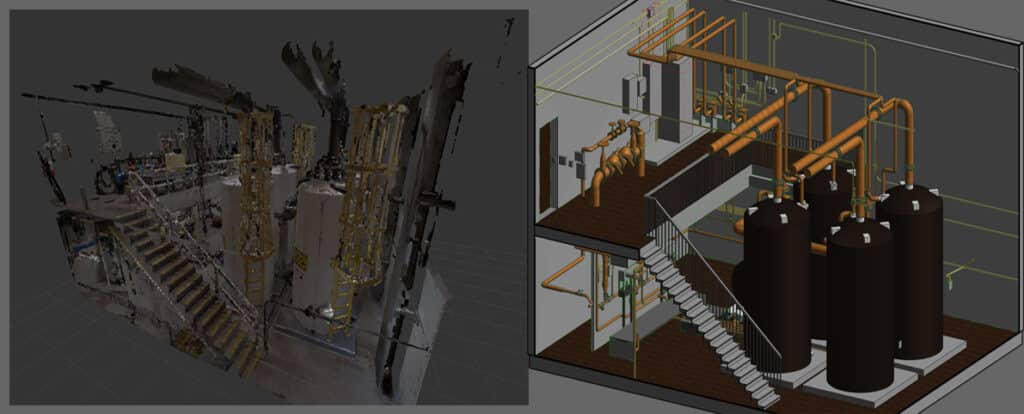Point Cloud to BIM Services

We are a leading BIM Company providing highly accurate and cost-effective Point Cloud to BIM Services to global clients. Our high client satisfaction ratio can be attributed to our extensive domain specific knowledge, 16+ years of experience and a proficient multi-disciplinary team. We operate with the aim of building prolific partnerships and offering superior deliverables in quick turnaround time.
We follow a meticulous point cloud to BIM workflow wherein we work in association with our clients to create detailed and precise Scan to BIM models of LOD 100-500. We work on various scan formats such as .RCP, .E57, .PTS, .RCS etc. and can expertly model existing elements of architectural, structural and MEP disciplines. Whether it a commercial or a residential building or a historical structure our BIM models facilitate informed decision making throughout the refurbishment, retrofit, reconstruction or facility management process.
What sets us apart from the other Scan to BIM Services providers is our unique client centered approach, our strict adherence to all international codes and standards and the ability to consistently surpass our clients’ expectations.

Architectural Point Cloud Conversion
We create information rich 3D models and 2D drawings for architectural elements such as walls, doors, windows, ceiling, roof, etc. from point cloud data. Our BIM modeling experts develop precise floor plans, elevations, sections that can be used by architects in renovation.

MEP Point Cloud Modeling
Our MEP point cloud modeling solution includes creating as-built models of mechanical (HVAC), electrical, plumbing and firefighting components for residential buildings, commercial and retail spaces.

Structural Point Cloud to BIM
We create BIM models from laser survey data for structural elements such as beams, columns, trusses, etc. We work for diverse kinds of building and infrastructure projects that includes bridges, tunnels, dams, train station, etc.
Inputs
- Registered or un-registered laser scan (point cloud data) inputs in .RCS, .RCP, .E57, .PTS formats
- Photos, 3600 videos, 2D drawings or any other additional information
Deliverables
- Accurate (up to 2 mm for as-built environment) 3D BIM models
- 2D drawings, if required
Benefits of Scan to BIM Services
#1 Save surveying time:
Using a laser scan technique can save a lot of time in surveying an old building or any existing site that requires renovation. A survey company can invest in a good laser scan equipment and scan the building into different phases. This is easier than having 3 to 4 technicians on site taking measurements. This reduces the cost and effort by 40% in total. You can easily capture the components and their 3D geometry using laser beams which later can be converted in scan images. This reduces field time to a great extent.
#2 Accurate Results:
High precision and accurate data collection are one of the most important advantages of using san to bim modeling. If the data collection is accurate, the conversion of scan to BIM models will definitely give great results. Traditional surveying never guaranteed accurate results. It depended a lot on the technician’s understanding, his judgments and other factors. Usage of scanning to a great extent improved accuracy criteria along with visibility of deepest entrenched building components such as beams, pipes etc.
#3 Detailed building analysis:
Converting laser scans to BIM models has brought about a colossal transformation in reviewing and analyzing any typical building. Previously a building put up for renovation or re-structuring process consumed a lot of time. Many issues in the previous design, deteriorated building components were not visible during surveying and had to be unearthed only during actual demolition. But this process has changed for good with the advent of laser scanning. All the critical issues and building components are visible during scanning and can be analyzed completely before the renovation process begins.
Building analysis process goes hand in hand with the scan to BIM modeling process. The laser scans are first converted into detailed BIM Models with all kind of building data incorporated in it. This model is analyzed later for the damaged building components, redesigning of the building, implementation of BIM compliances prior to construction etc. We also can further analyze the costing, budgeting, timeline and interferences that arise while reconstructing. Building analysis is one of the most important parts of scan to BIM conversion process.
#4 Design Assessment for renovation:
Design validation or assessment has become extremely effective by using scan to BIM modeling. Scan to BIM conversion is used mostly for renovation and refurbishment of old and existing structures. Hence validating the new designs become a very important step before proposing a design for construction. As we know, scanning a building into different laser images and processing them to generate a seamless scan image is the first step. Later this scan is used to develop a 3D BIM model with all details, levels, and components such as beams, columns, slabs, doors, windows or any MEP component for that matter. This model will give a very comprehensive picture of the existing building design and also help us develop the new design.
There may be many up gradations that the existing site may require. The site may need to be reconstructed based on new design codes, new parameters or environmental standards. All these needs can be assessed by looking at the 3D model developed from laser scans. You can also model the new design as an extension of old design. You can also perform interference checks by comparing the new design model with old. Point cloud to BIM modeling also ensures complete accuracy as the as-built model is not dependent on the manual survey but dependent on the actual image of building through scanning.
#5 Seamless Collaboration between multiple teams
Point Cloud to BIM Modeling is extremely useful in establishing collaboration between Design Engineers Architects, contractor and end user. By developing 3D models from scans, one can understand the existing design and discuss the proposed designs too. It becomes easier to understand the design flaws, the updations required in the new proposed design. The BIM Engineer can integrate the Architectural, Structural and MEP model developed from scans into a coordinated 3D model to further identify potential threats, interferences, and design issues in the existing structure and solutions to correct them.
#6 Reducing overall cost: Scan to BIM modeling helps in reducing overall surveying and construction costs. Traditional surveying methods are extremely costly and time consuming compared to laser scan surveying. When it comes to as-built modeling, point cloud BIM modeling has proved to be a savior in construction planning and budgeting. The best part is that owing to the virtual construction modeling, errors and issues can be detected earlier during the project life cycle which reduces the overall construction costs. Even the labor cost is reduced since you have a laser scanner that actually scans the building instead of a technician.

